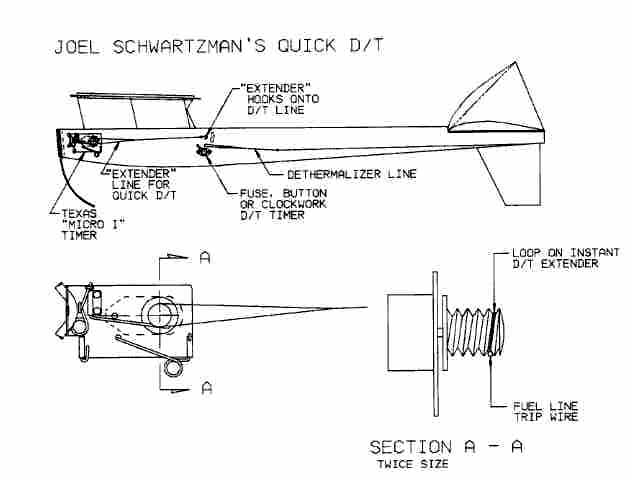
A QUICK DT APPLICATION USING THE MICRO I TIMER
Joel Schwartzman
4480 W. Sweetwater Dr.
Tucson, AZ 85745
(520) 743-8322
verylazyj@aol.com
This application originally appeared in the August/September 2001 issue of the National Free Flight Society Free Flight Digest and is republished with permission of the NFFS and the author, Joel Schwartzman. The information presented here includes more recent updates by the author. Drawing provided by Jim O'Reilly.

Quick DT capability has saved many a power model from an early death. This system is shown in Jim O'Reilly's CAD drawing mounted in a Space Rod and operating from the scroll of a Texas Micro I Timer. Here's what the developer of this system has to say about it.—the editor.
The bane of free flight is getting past a new model's first two or three flights. More advanced timers, heavier and more expensive, provide an instant DT, which greatly improves the model's ability to survive this period.
I have used Texas Timers' Micro I timer with great success over the past year, with more than 1,000 (correct) flights. It has outstanding lightness and reliability. All it lacked was an instant DT function. The illustration shows how to add that function, which I am using on a 300 sq-in. Nostalgia model, powered by an OS 099.
The timer scroll rotation drives the fuel shutoff tripwire off the scroll. A fraction of a second later, the Dacron line loop exits the scroll, allowing the stab to pop up for an instant DT. If you want to program a delay in the DT, just place the Dacron loop in a thread on the scroll that is further in from where you place the shutoff tripwire. The delay will be approximately six seconds per thread displacement.
When I am not using the instant DT application I merely remove the line or let it dangle and wrap the elastic line around the arm of the DT timer (button or mechanical) in the normal manner. When using a fuse, remove the instant DT line. Of course, when using the instant DT line, it bypasses the fuse or DT timer.
It is important that the length of the Dacron line be adjusted so it allows sufficient tension to hold the stab in place, yet it doesn't place excessive pressure on the scroll. I've found that sufficient tension will reduce scroll rotational speed about 5%. As this is only for short-run testing, the deviation is of no consequence.
[Caution is the watchword in applying quick DT. It can be a godsend in testing a new model. But it can quickly fold a wing—especially Nostalgia and OT types—if deployed too quickly. Delay DT until climb speed sufficiently dissipates. - the editor]
For those interested in seeing how a real installation of this looks, click Here to see how Don DeLoach did it on his Starduster X.
For more information on The National Free Flight Society
and how to belong click here
![]()